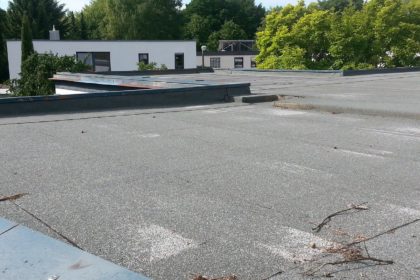 How Long Does a New Flat Roof Last?
How Long Does a New Flat Roof Last?
A roof can be either flat or pitched, depending on the building’s needs. Flat roofs are often associated with commercial buildings, but they’re also the best solution in many residential circumstances. These may include anything from a block of flats to an extension or outbuilding.
In general, flat roofs tend to be both cheaper and shorter-lasting than pitched roofs, but there are many steps you can take to extend the life of your flat roof.
What Factors Affect the Life of Your Flat Roof?
A major factor determining how long your flat roof will last is going to be the prevailing weather conditions. If your building is near the coast, for instance, it’s likely to be subject to heavier wind and rain, which can cause water pooling. This increases pressure on the roofing materials and can result in damage.
In the same way, if you’re on high ground or exposed to the north, there may be a greater risk of freezing. Repeated freeze-thaw cycles create tears in the material, allowing moisture to seep down into the building below and cause mould, rot or mildew.
Pooling water can also be a risk if the roof isn’t designed to drain properly. Even a “flat” roof should have some pitch that allows water to run off into the guttering, rather than remaining where it falls.
Materials for a Flat Roof
The single most significant issue, though, for how long a new flat roof will last is the materials used. Durability varies, although it’s sometimes offset a little by the cost and ease of replacing the roof.
- Felt roofing, the traditional material for flat roofs, is likely to last up to 20 years. The cost is relatively low, but it may not be the best option in more extreme climates, due to its vulnerability to UV and its tendency to allow pooling.
- Fibreglass roofing produces an attractive look and is resistant to water, fire and impact. It typically lasts 20-30 years, but the downside is that it’s not suitable for installation on all surfaces.
- PVC roofing is most common for industrial buildings and offers excellent resistance to UV, chemicals and punctures — but it’s not easy to install correctly. A PVC flat roof should last 20-30 years.
- Liquid rubber roofing is a low-cost, tough and long-lasting system that’s resistant to weather, impact and chemicals and can last up to 50 years. The best thing about liquid rubber, though, is that it’s very versatile and inexpensive, since it can be rolled over your existing roofing materials.
How to Extend the Life of Your Flat Roof
Besides the materials and the various external factors, the lifespan of your flat roof will depend on two crucial things — how expertly it’s installed in the first place and how well it’s maintained afterwards.
Installing any roof is a complex procedure that should only be undertaken by specialists, and shoddy work will mean it needs to be replaced far sooner than the times given above. It’s also recommended to have your flat roof inspected once a year by professionals, who’ll be able to spot and repair issues long before they become serious problems.
Give Empire a call to find out more about our guaranteed services for installing and maintaining flat roofs — or any kind of roof, for that matter.









